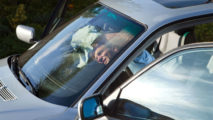Last Updated on January 21, 2022
If you’ve ever gotten fed up with washing your car because you’re a bit of a perfectionist, then there’s a chance you’ve run into this problem: water spots on your glass.
While it might seem like a small issue that you should just ignore, for some, it’s the cause for a lot of frustration. Keep reading to learn how to get rid of water spots and prevent them from forming in the first place.
Related: How to Properly Clean the Inside of a Windshield
What Causes Water Spots on Glass?
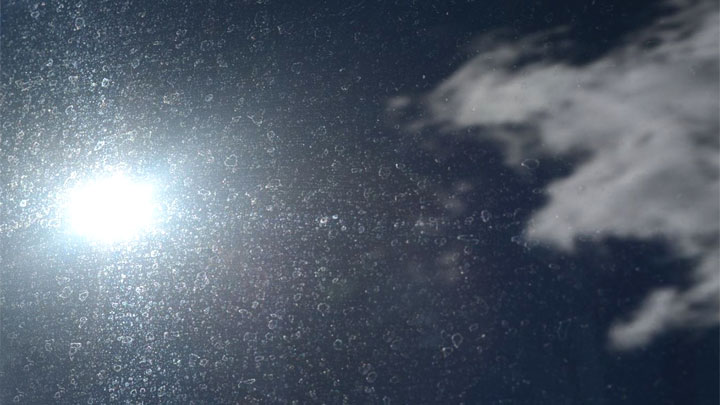
Essentially, water spots on your glass are caused by the buildup of minerals like magnesium and calcium. When it rains or you wash your car using plain old tap water that gets to your house from your town’s water district or a well, the minerals in the water start to build up. Some areas have naturally “harder” water than others and the water spots will be worse.
While this might seem crazy, even if you scrub your windows after each wash or storm, these minerals will still build up. If you look closely, you’ll see that each of these “spots” is really the outline of whatever shape the water beads up as. Then, around the circumference of the oblong shape, you’ll see the minerals have accumulated.
How to Get Water Spots Off Car Windows
Now, the reason you’re here is probably because you want to get water spots off of your car windows or mirrors. If it’s truly bugging you, like it does me, give these methods a try:
Method #1 – Water Spot Remover Product
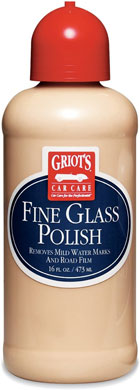 One way to get water spots off your car windows is to get a “water spot remover product” like glass polish. Here are three of our favorite products:
One way to get water spots off your car windows is to get a “water spot remover product” like glass polish. Here are three of our favorite products:
- Griot’s Garage Glass Polish is the best option we’ve tested. It uses a careful cocktail of acids and oxides to get rid of pretty much every water spot you could find on your glass. It’s the brand that “serious” car guys and gals trust, so if that’s your thing, it’s hard to beat Griot’s.
- Next best is Chemical Guys HD Water Spot Remover, which is also a well-respected brand and seems to provide a similar result. It even waxes the surface in order to (hopefully) prevent future water spot issues.
- Duragloss 755 is our final contender here, and it proves to be just as effective as the others but may cost a bit more. What it does do is simultaneously clean and lubricate the glass surface to help prevent future spots, squeaky windshield wipers, and prolong the life of your blades.
See Also: How to Remove Scratches on a Windshield
Method #2 – Vinegar
 Now, if you are as cheap as me, you’ll probably try everything in–or under–the kitchen sink before you get on the Google machine to buy something. I recommend you start with vinegar, as it’s a super handy household cleaner that pretty much every household has access to.
Now, if you are as cheap as me, you’ll probably try everything in–or under–the kitchen sink before you get on the Google machine to buy something. I recommend you start with vinegar, as it’s a super handy household cleaner that pretty much every household has access to.
- First, take some vinegar and mix it in equal parts with water. This is a good place to start, but you can always strengthen the solution with more vinegar should you need to.
- Next, take your new solution and either pour it into a spray bottle (if you roll that way) or pour it into a microfiber or regular dish towel. If you want to spray, spray the towel and not the glass for starters.
- Then, take the saturated towel and rub the ever living crap out of your window where you see the spots. The towel will act as some much-needed abrasion to that surface to break up those mineral deposits, no matter how small.
- Finally, once you feel you have covered the area as best you can, wipe off the water/vinegar solution with a clean, dry towel (or paper towel). This way, you are clearing the surface of any liquid particles that could leave more spots.
I want to add that you can also use baking soda in this situation (instead of vinegar). I don’t see the point, but it seems to work. Just make sure you don’t do something silly like mix an acid (like vinegar) with an alkali like baking soda. Nothing will happen and they’ll cancel each other out.
If you have a spot that just won’t budge, try spraying pure vinegar directly on that area and let it sit for 30 minutes to do some work. Then try wiping it off.
Method #3 – Lemon
Just like it sounds, slice a lemon in half and rub some on that spot! Then let the acid do some work, for a couple minutes. Finally, rub it off just as if you were using vinegar!
It’s worth a shot, especially if you have some lemons or limes lying around in your fridge. Make sure you make a nice mojito afterwards for your friendly writer, Al.
Method #4 – Clay Bar
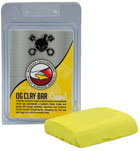 If the above methods don’t work for you, you should try using a clay bar. This is a proven method to remove tar, sand, muck, sap, rubber, oil, and you guessed it, WATER SPOTS!
If the above methods don’t work for you, you should try using a clay bar. This is a proven method to remove tar, sand, muck, sap, rubber, oil, and you guessed it, WATER SPOTS!
Chemical Guys makes a great clay bar kit to help you with this water spots issue, and they even provide the helpful video below.
Mothers also makes a clay bar kit, and they smell nice so you could try that as well. Mothers, as a company, has been around for a long time, so I trust their products as well.
Method #5 – Steel Wool
Another method for removing water spots from your glass is to use #0000 (super fine) type steel wool to scuff up the surface. Wet the steel wool pad before you do this, then, making small circular motions, tackle the hardest-to-remove water spots.
This is very important: don’t press too hard, and be careful. Too much pressure can scratch your glass and you’ll hate that. This should work for you, and really, if it doesn’t and you have tried everything else in this article, it’s probably not a normal water spot.
It could be an intense solvent, some oil or acid, or someone has been painting little circles on your windows ever-so-slowly… that’s an ingenious prank.
Method #6 – WD-40
Does WD-40 remove water spots? Everything I can find on Ye ‘Old internet says that WD-40 will work great for removing water spots on pretty much any type of glass surface. Just take your WD-40 and apply the same method we used with vinegar above.
- Spray that WD-40 into a towel.
- Then rub as hard as you can on that glass part with the water spots.
- Let it sit for a minute or two
- Wipe it away with a dry microfiber, dish, or paper towel
I will say that if you’ve somehow stumbled upon this article and you’re going to use this method on a glass cutting board, just make sure to wash the WD-40 off as it’s not food safe.
Read Also: 7 Best Windshield Chip Repair Kits
How to Prevent Hard Water Spots on Car Windows
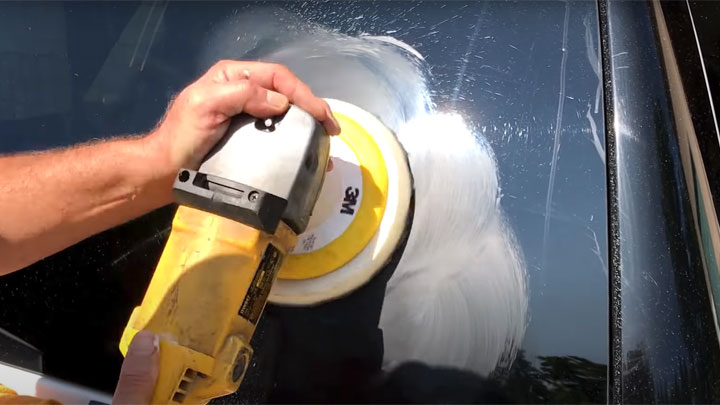
Option #1 – Wax
One great way to prevent pretty much anything from actually sticking to your glass surface or your paint is to wax the surface. Waxing a sloped glass surface will prevent water form beading up at all, or staying on that surface for long.
You may have noticed this effect if you’ve gone to a car wash and you see the small water beads running along the side of the windows as you drive down the road. They look like they aren’t sticking to the window, or like there’s some sort of forcefield keeping the water away.
This is because a lot of car washes these days include a wax treatment in their options. Tar, sap, and water spots will have a smaller chance of sticking if the surface has a thin wax layer over it.
There are many good brands of car wax but P21S, Meguiar’s Gold Class, and Chemical Guys Butter Wet Wax should be at the top of your list.
Related: 6 Tips for Do-It-Yourself Auto Detailing
Option #2 – Rain-X
Rain-X has been around for decades and is a good option to prevent or reduce water spots on your windshield. It works similar to wax and although it’s in a liquid form, it’s essentially applied the same way.
It’s a good, cheap option but won’t last very long so you’ll need to reapply more frequently.
Option #3 – Sealant Treatment
Using what’s called a “paint sealant” is a good way to prevent water spots from forming on the surface of your paint for a good 6 months. In order to do this effectively, you’ll need to complete a few steps first:
- First, prepare the surface.
- Wash the surface thoroughly
- Remove all contaminants with a clay bar
- Machine polish the surface
- Then, do a final wipe down
Once you’ve done the prep work, head over to this in-depth guide on sealing your paint. They explained it much better than I could. Also, while this method is technically for your paint, it offers another option to prevent water spots from actually sticking on your paint.
Option #4 – Wash Your Car Section-by-Section
Trust me, just try it once. We hate to admit it, but a lot of these water spots are a direct result of us trying to wash our cars in the driveway with hose water from city water or your well. In many regions throughout the USA, local water sources are “Extremely” hard. They contain a lot of minerals which will wreak havoc on your paint, windows, and wax.
If you’re trying to wash your car, and you’re rushing through the process trying to do the whole car at once, you may not be able to wipe away the water with a dry towel in time! This will leave hard water spots on your car’s surfaces, and you’ll have to do the whole thing again!
Instead of that rushed method, try doing one panel or section at a time. Wash, rinse, dry, and then wax that panel. While the wax dries, go over to the other side of the car and wash it so you don’t get overspray if you’re using a hose. If you do, it’s not a big deal because you’ve already waxed that panel. See what I’m getting at here, try to adjust your methods if what you’re doing isn’t working.
Another method would be to take your car to a professional car washer or detailer. They’ll be able to take care of your water spots and might even offer some helpful suggestions you can apply and share with your buddies. But it won’t be cheap and tipping is often expected.
Finally, Garage Tool Advisor’s “How to Detail a Car Exterior” does a good job of explaining what a full DIY car exterior detail entails. It’s a good guide to follow if you have the time. Otherwise, take it to a pro as mentioned above.
Option #5 – Keep Your Car Covered
If rain is in the forecast, the best thing to do is keep you ride under cover. This could be in a residential garage, covered commercial garage, carport, or under a good car cover.


